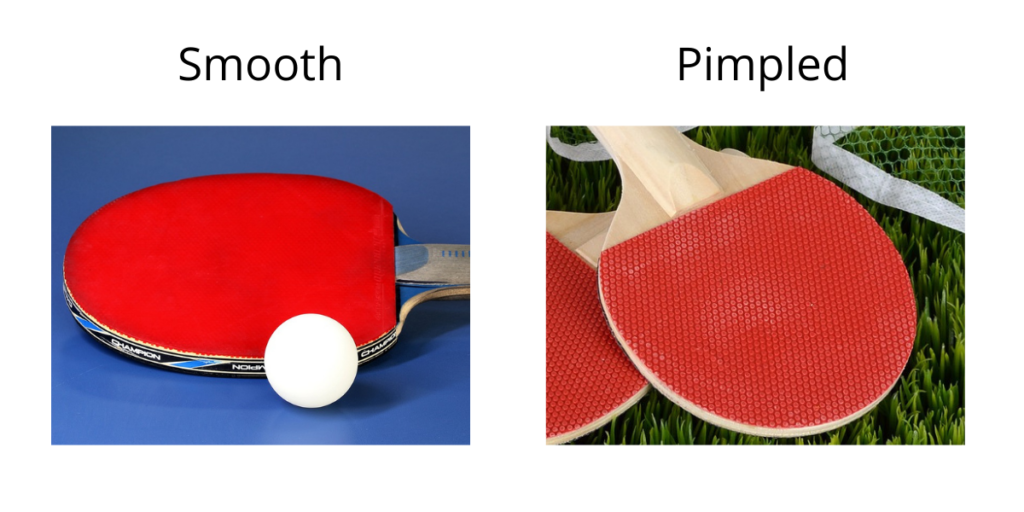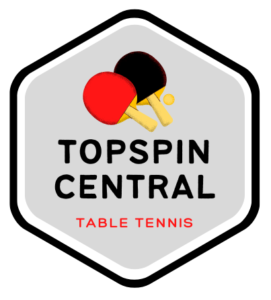There are many types of rubber to choose from when selecting a ping pong paddle, but which is the best? In this article, I’ll compare the different types of table tennis rubber and the pros and cons of each so you can decide which is the best option for you.
Types of Table Tennis Rubber
There are 4 types of table tennis rubber:
- Inverted
- Short Pips (pimples)
- Long Pips (pimples)
- Anti-Spin
Smooth vs Pimpled
Inverted (smooth) table tennis rubber provides more spin than pimpled rubber. Pimpled rubber is useful for defensive players as it reduces the impact of the spin generated by the opponents shots. Inverted rubber offers more control and is often preferred by beginners and most professionals.

1. Inverted (Smooth)
Inverted rubber is named because the pips face inwards towards the sponge, providing a smooth surface. This is the most popular ping ping rubber type and offers the most control. The smooth surface gives you more surface area to make contact with the ball, which allows you to generate spin more easily.
The majority of professionals use inverted rubber, but it is also recommended for beginners as well. The extra control offered by the smooth surface makes it easier to learn different kinds of shots and get to grips with different techniques.
Popular smooth (inverted) table tennis rubbers
– Butterfly Tenergy
– Butterfly Dignics
– DHS Hurricane
– XIOM Vega Pro
– Yasaka Rakza 7
Good for:
- Beginners and professionals
- Generating spin
Not so good for:
- Defensive styles
- Slowing the pace down
Tacky vs Non-Tacky Inverted Rubber
Inverted (smooth) table tennis rubber is split into two types: tacky and non-tacky. Tacky rubber is capable of producing more spin, but is more difficult to use. Non-tacky rubber is better for smashing and feels more powerful and faster.
Check out my comparison between tacky and non-tacky rubbers for more info.

2. Short Pip (Short-Pimple)
Short pimple rubber provides less surface area than inverted rubber, but more than long pimple rubber. The reduced surface area compared to inverted rubber means that short pimple rubbers have less grip which means less control.
This is typically why beginners should not choose pimpled rubber as it makes it harder to learn techniques and generate spin.
Short pimpled rubber is useful for deadening the spin generated by the opponents shot, this makes it popular for counter-attacking players who use blocking and smashing techniques.
Popular short-pimple table tennis rubbers
– Andro Hexer Pips Force
– DHS 651
– TSP Spin Magic
– Tibhar Speedy Soft D.Techs
– Andro Blowfish
Good for:
- Blocking
- Smashing
Not so good for:
- Generating spin
- Learning new techniques

3. Long Pips (Long-Pimple)
Long pimple rubber provides less surface area than inverted and short-pimple rubber. This type of rubber is often chosen by defensive players as it allows you to deaden the spin generated by the opponent’s shot, or actually reverse it with good technique, giving the player potent counter-attacking ability.
Long pimple rubber is slower than short pimple rubber, this can give the player more time to control the ball with long pips, again making it useful for defensive players who are waiting for an opportunity to counter-attack.
Popular long-pimple table tennis rubbers
– Butterfly Feint Long
– Tibhar Grass Ultra
– Curl TSP
– Giant Dragon Cropcircles
– XIOM Guillotine S
Good for:
- Defensive players
- Reversing opponent’s spin
Not so good for:
- Speed (long pips are slow)
- Beginners and learning techniques
Check out my comparison between long and short pip rubbers for more info.
4. Anti-Spin
Anti-spin rubbers do not have any pimples and instead have a smooth and slippery surface which has very low friction.
This type of rubber is popular with defensive players as it allows you to reverse the spin generated by the opponents shot, so if an opponents uses a lot of top spin, your returning shot will have backspin if you se the correct technique.
Popular anti-spin table tennis rubbers
– Butterfly Super Anti
– Yasaka Anti-Power
– Friendship 729/ 804
– Dr Neubauer Tarantula
– Nittaku Best Anti
Good for:
- Counter-attacking
- Players who prefer slower-paced games
Not so good for:
- Speed (anti-spin rubber is slow)
- Beginners and learning techniques
Which Rubber Type is Best?
The type of rubber that’s best suited to you depends on your playing style. Here is a table to compare the pros and cons of each rubber.
| Inverted (Smooth) | Short Pimpled | Long Pimpled | Anti-Spin |
| Good for beginners | Moderately suitable for beginners | Not good for beginners | Not good for beginners |
| Suits offensive and all-round players | Suites all-round players | Suits defensive players | Suits defensive players |
| Most spin | Moderate spin | Low spin | Low spin/ anti-spin |
| Fast | Moderate speed | Slow | Very slow |

Chinese vs European Rubber
Chinese ping pong paddle rubber is stickier than European/ Japanese-style tensor rubber. The tackiness of Chinese rubber increase the level of control and spin, however it is slower to play with compared to tensor rubber which has a “bouncier” feeling.
Check out my comparison between Chinese and Euro/ Japanese rubbers for more info.
The Sponge Layer
When players refer to the “rubber” on a ping pong paddle, they are often referring to the overall structure of the sponge and rubber top-sheet.
Thinner sponge layers are recommended for defensive style players as they offer more control and feel, whereas thicker sponges are faster and more powerful, they are also good for generating more spin when using the looping technique.
Check out my comparison between thick and thin sponges for more info.
| Sponge Thickness | Player Type |
| <1.5 mm | Defensive |
| 1.5-2.2 mm | All-round |
| > 2.2mm | Offensive |
More Questions
Here are the answers to some more frequently asked questions about table tennis paddle rubbers.
Which is better, hard or soft rubber?
Harder rubber offers more power, and consequently speed compared to softer rubber. Harder rubber offers more spin capability, but the spin is harder to control when compared with softer rubber. This is why beginners often find softer rubber easier to use.
Check out my comparison between hard and soft rubbers for more info.
What is the difference between forehand and backhand rubbers?
Some players choose to use a faster rubber with more spin on the forehand, and a slower rubber with a deadening or anti-spin effect on the backhand. When you hit the ball using your forehand, the longer stroke creates more power and speed compared to when you hit it with your backhand, so some players use rubbers with different characteristics to either balance or emphasise the differences between the strokes.
The black side of the bat is generally used for the forehand as it is sticker than the red side which is often used for the forehand.
